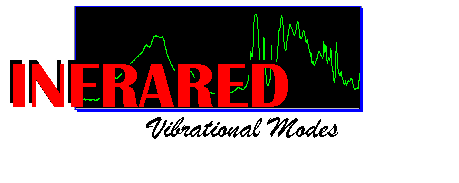 Retour
à la page spectroscopie
Retour
à la page spectroscopie
Les groupes d'atomes dans une molécule ne vibrent pas seulement chacun à leur fréquence, il y a six façons différentes de vibrer pour chaque molécule. Toutes ces vibrations peuvent avoir lieu dans chaque molécule mais elle se ferons à des fréquences différentes. Ces six modes sont représentés dans l'animation Shockwave ci-dessous.
| vibration | fréquence (cm-1) |
| carbonyl (C=O) stretch | 1870 - 1650 |
| Alcools | |
| O-H stretch | 3640 - 3250 |
| C-OH stretch | 1160 - 1030 |
| C-OH in-plane bend | 1440 - 1260 |
| C-OH wag | 700 - 600 |
| Alcanes | |
| C-H stretch | 2980 - 2850 |
| CH2 wag | 1470 - 1450 |
| CH2 rock | 740 - 720 |
| CH3 wag | 1390 - 1370 |
| CH3 twist | 1470 - 1440 |
| Alcènes | |
| =CH2 stretch | 3040 - 3010 |
| =CH2 wag | 950 - 900 |
| C=C stretch (cis isomer) | 1665 - 1635 |
| C=C stretch (trans isomer) | 1675 - 1665 |
| Amines | |
| N-H stretch | 3460 - 3280 |
| NH2 wag | 1650 - 1590 |
| C-N stretch | 1190 - 1130 |
| C-N-C scissor | 510 - 480 |
| Esters | |
| C-O-C asymmetrical stretch | 1290 - 1180 |
| O-C-O scissors | 645 - 575 |
| Nitro compounds | |
| NO2 symmetrical stretch | 1570 - 1550 |
| NO2 asymmetrical stretch | 1380 - 1360 |
| NO2 scissors | 650 - 600 |
| NO2 rock | 530 - 470 |
| Sulfones | |
| SO2 symmetrical stretch | 1170 - 1120 |
| SO2 asymmetrical stretch | 1360 - 1290 |
| SO2 scissors | 610 - 545 |
 Retour
à la page spectroscopie
Retour
à la page spectroscopie Retour
au sommaire de macrogalleria
Retour
au sommaire de macrogalleria